So far this year in New York I have seen Red-eyed Vireos, White-eyed Vireos, Warbling Vireos, Yellow-throated Vireos and Blue-headed Vireos. The Philadelphia Vireo, which nests much further north and only in scattered locations in the Adirondacks, has eluded me. Eluded me, that is, until Sunday.
On Sunday morning at 6:30 AM a fellow Albany-area birder, Tom, who, as I have mentioned before, is the birder who has showed me more lifers than any other, picked me up and we headed over the Hudson River to the Rensselaer Tech Park, a business park with large fields, brushy areas, and woodlands. The three days of south winds had relented, a front had gone through, and the migrating birds had arrived!
Almost as soon as we stepped out of his car a confusing fall warbler confounded us. We worked on it for fifteen minutes or so before deciding to let it go and see if we could find some birds that we could get good enough looks at to identify.
And did we see birds!
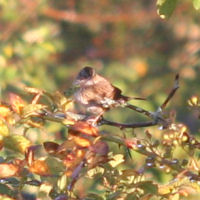
one of our three Lincoln’s Sparrows
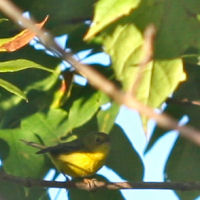
one of two or three Wilson’s Warblers
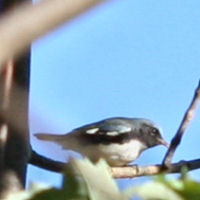
one of two Black-throated Blue Warblers
In addition to the birds above we also spotted a Wood Thrush, two Blackpoll Warblers, a Least Flycatcher, a Sharp-shinned Hawk, a Blue-headed Vireo and many other birds. It seemed like we couldn’t walk five steps without seeing a bird or birds. Not knowing which bird to focus on is a wonderful problem to have! And it was pretty cool to hear a bunch of coyotes yipping and howling in response to a distant siren too.
Then, as we were about to move into the woods from a trail through thick brush I spotted some birds flying across the trail behind us. As I was trying to get them in my bins I heard Tom, up the trail a bit, exclaim “Tennessee Warb…no wait, Philly?”
Needless to say I made great haste in arriving at his side and pointing my bins in the general direction his were pointed. The bird moved along the edge of the trees, never giving a great view, but many short views. First, a look at a pale yellow chest. Then the yellow wash on the undertail. Then, finally, a look at the thick bill, gray cap, and distinct white supercilium. Philadelphia Vireo! A bird I had only seen once before, ever, and bird number 286 for the year in New York!
It paralleled our path as we entered the woods, never coming close, but occasionally letting us get another look. Then we came upon this bird which took us no time at all to identify. Can you figure it out?
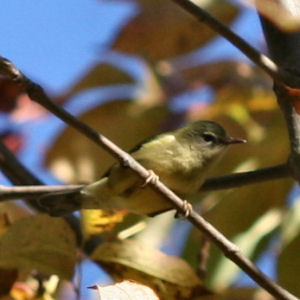
one key field mark is not visible
We walked back to the parking lot on a different trail, watching a Sharp-shinned Hawk in a duel with some American Crows while Blue Jays screamed and not seeing much else.
When we got to the car we started paging through our field guides, trying to figure out what our mystery warbler at the beginning of our outing was. We had some disagreement over some of the field marks and had pretty much given up hope of identifying it when Tom spotted it hover-gleaning on some phragmites, not ten yards from where we had seen it earlier.
This time we refused to let it get away unidentified. We saw a bird with yellow undertail coverts that extended almost to the tip of the tail, a complete eye-ring, a pretty big bill, yellow underparts generally, a dark and unmarked back, wings, and tail, pink legs, and some indistinct streaking on its neck. When a Common Yellowthroat foraged near it we saw that our mystery warbler was bigger. No other birds were around to compare it to. It finally struck us that we were looking at an Oporornis warbler, specifically, Oporornis philadelphia, or, in plain English, a Mourning Warbler.
It was a first-fall bird and we surmised that the indistinct streaking on its neck was the beginning of a hood, a conclusion confirmed by Pete Dunne’s description of a juvenile Mourning Warbler’s hood in his Essential Field Guide Companion: “Immatures have a…shadowy poorly defined bib with a broken border and a yellow core.” He also describes juveniles as having a “narrow, barely-broken, circular white eye-ring.”
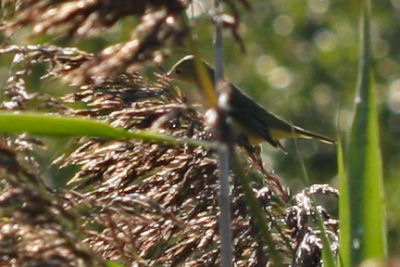
first fall Mourning Warbler
Our day’s birding wasn’t done yet though! We decided that the birding had been so good at the Rensselear Tech Park that we would see what was moving at Papscanee Island. But before we even got a mile up the road my phone rang and Zach, another local birder, excitedly let me know that he had found an American Golden Plover at the Cohoes Flats! Tom hadn’t seen one in years and I had only seen one before so we made tracks to Cohoes to check it out, calling Will while en route to alert him to the find.
When we got there Zack told us that he had made an error. “Oh no” I thought, “He saw a Black-bellied Plover and decided it was a golden.”
But his error turned out to be that there were not one but two American Golden Plovers! After checking the distant birds out and congratulating Zack on his noteworthy find we headed to the south end of the Papscanee Island Preserve.
While walking in the thick woods the wind was rather strong and there were virtually no birds. A couple Red-bellied Woodpeckers were coughing off in the distance but the place was mostly quiet in terms of avians. We finally found a single Magnolia Warbler and some Gray Catbirds and figuring we had already used up our birding mojo on the Philadelphia Vireo, Mourning Warbler, and American Golden Plover we decided to call it a day.
As we were walking out we came across another local birder, John, who informed us that he had just had a nice mixed flock that moved too fast through the thick foliage for him to identify too much but at the least there was a Pine Warbler amid the throng. We let him know about the American Golden Plovers and were then interrupted by some chip notes that I should have recognized, seeing as I heard them the day before. It took us a bit, but we figured out the notes were coming from an Ovenbird that was traveling along in the company of our third Black-throated Blue Warbler of the day.
Tom and I wished John good birding and continued on our way until we heard the distinct “chick-a-dee-dee” sound that to our ears meant not only Black-capped Chickadees but warblers that would certainly be foraging with them as well. We were not disappointed. A Black-throated Green Warbler showed itself shortly after some Red-eyed Vireos. Then Tom found our second Philadelphia Vireo of the day, this one much brighter than the last. While watching the vireo we let the rest of the flock escape unidentified. Such are the trade-offs one makes while birding.
All-in-all it was a heck of a half-day’s birding. Now if I could just find an Orange-crowned Warbler…











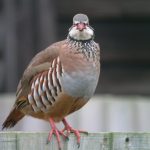
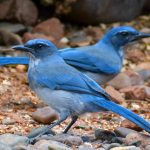
Wow, what a day! You still have time to get that OC Warbler. As for the mystery bird, is it a BT Blue?
Got it on the first shot!
The field mark that isn’t visible is the white patch on the wing…and, not for nothing, every field guide I consulted showed the stripe over the eye continuing much further back. I wonder if this is an indication of female vs. first-year male?
I was wondering about that eyestripe too. I’ll do some research at home if I remember.